一、简介
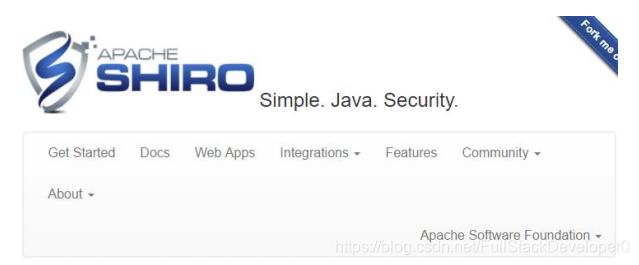
• Apache Shiro 是 Java 的一个安全(权限)框架。
• Shiro 可以非常容易的开发出足够好的应用,其不仅可以用在JavaSE 环境,也可以用在 JavaEE 环境。
• Shiro 可以完成:认证、授权、加密、会话管理、与Web 集成、缓存等。
• 下载:http://shiro.apache.org/
二、功能简介

1. Authentication:身份认证/登录,验证用户是不是拥有相应的身份
2. Authorization:授权,即权限验证,验证某个已认证的用户是否拥有某个权限;即判断用户是否能进行什么操作,如:验证某个用户是否拥有某个角色。或者细粒度的验证某个用户对某个资源是否具有某个权限
3. Session Manager:会话管理,即用户登录后就是一次会话,在没有退出之前,它的所有信息都在会话中;会话可以是普通 JavaSE 环境,也可以是 Web 环境的
4. Cryptography:加密,保护数据的安全性,如密码加密存储到数据库,而不是明文存储
5. Web Support:Web 支持,可以非常容易的集成到Web 环境;
6. Caching:缓存,比如用户登录后,其用户信息、拥有的角色/权限不必每次去查,这样可以提高效率
7. Remember Me:记住我,这个是非常常见的功能,即一次登录后,下次再来的话不用登录了
三、Shiro架构
1. 从外部来看Shiro ,即从应用程序角度的来观察如何使用 Shiro 完成工作

(1)Subject:应用代码直接交互的对象是 Subject,也就是说 Shiro 的对外API 核心就是 Subject。Subject 代表了当前“用户”, 这个用户不一定是一个具体的人,与当前应用交互的任何东西都是 Subject,如网络爬虫,机器人等;与 Subject 的所有交互都会委托给 SecurityManager;Subject 其实是一个门面,SecurityManager 才是实际的执行者
(2)SecurityManager:安全管理器;即所有与安全有关的操作都会与SecurityManager 交互;且其管理着所有 Subject;可以看出它是 Shiro的核心,它负责与 Shiro 的其他组件进行交互,它 相当于 SpringMVC 中DispatcherServlet 的角色
(3)Realm:Shiro 从 Realm 获取安全数据(如用户、角色、权限),就是说SecurityManager 要验证用户身份,那么它需要从 Realm 获取相应的用户进行比较以确定用户身份是否合法;也需要从 Realm 得到用户相应的角色/权限进行验证用户是否能进行操作;可以把 Realm 看成 DataSource
2. 从内部看Shiro架构
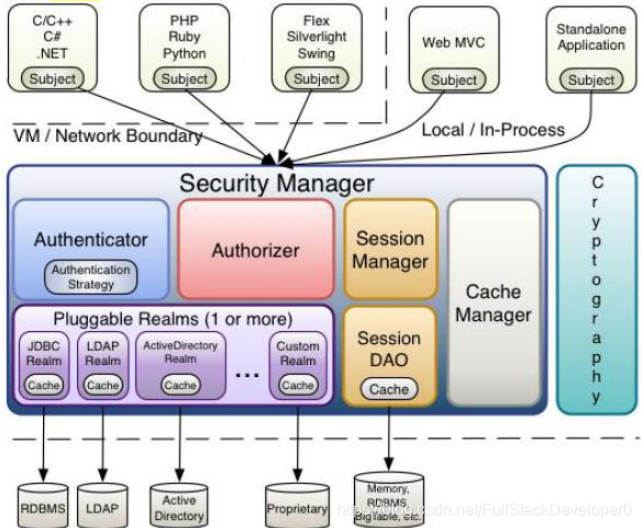
(1)Subject:任何可以与应用交互的“用户”
(2)SecurityManager :相当于SpringMVC 中的 DispatcherServlet;是 Shiro 的心脏;所有具体的交互都通过 SecurityManager 进行控制;它管理着所有 Subject、且负责进行认证、授权、会话及缓存的管理
(3)Authenticator:负责 Subject 认证,是一个扩展点,可以自定义实现;可以使用认证策略(Authentication Strategy),即什么情况下算用户认证通过了
(4) Authorizer:授权器、即访问控制器,用来决定主体是否有权限进行相应的操作;即控制着用户能访问应用中的哪些功能
(5) Realm:可以有 1 个或多个 Realm,可以认为是安全实体数据源,即用于获取安全实体的;可以是JDBC 实现,也可以是内存实现等等;由用户提供;所以一般在应用中都需要实现自己的 Realm
(6) SessionManager:管理 Session 生命周期的组件;而 Shiro 并不仅仅可以用在 Web 环境,也可以用在如普通的 JavaSE 环境
(7)CacheManager:缓存控制器,来管理如用户、角色、权限等的缓存的;因为这些数据基本上很少改变,放到缓存中后可以提高访问的性能
(8) Cryptography:密码模块,Shiro 提高了一些常见的加密组件用于如密码加密/解密。
四、简单的案例
1. 创建java的项目,并导入jar包
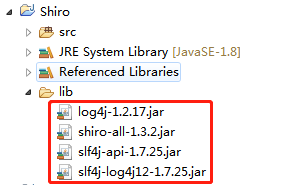
2. 粘贴配置文件

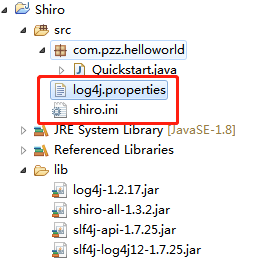
【提示】shiro-root的资源可以在git上下载
3. 粘贴案例helloworld

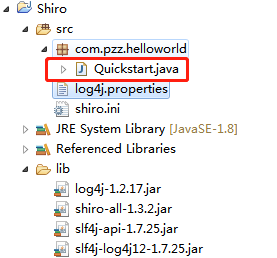
4. 运行
/*
* Licensed to the Apache Software Foundation (ASF) under one
* or more contributor license agreements. See the NOTICE file
* distributed with this work for additional information
* regarding copyright ownership. The ASF licenses this file
* to you under the Apache License, Version 2.0 (the
* "License"); you may not use this file except in compliance
* with the License. You may obtain a copy of the License at
*
* http://www.apache.org/licenses/LICENSE-2.0
*
* Unless required by applicable law or agreed to in writing,
* software distributed under the License is distributed on an
* "AS IS" BASIS, WITHOUT WARRANTIES OR CONDITIONS OF ANY
* KIND, either express or implied. See the License for the
* specific language governing permissions and limitations
* under the License.
*/
import org.apache.shiro.SecurityUtils;
import org.apache.shiro.authc.*;
import org.apache.shiro.config.IniSecurityManagerFactory;
import org.apache.shiro.mgt.SecurityManager;
import org.apache.shiro.session.Session;
import org.apache.shiro.subject.Subject;
import org.apache.shiro.util.Factory;
import org.slf4j.Logger;
import org.slf4j.LoggerFactory;
/**
* Simple Quickstart application showing how to use Shiro's API.
*
* @since 0.9 RC2
*/
public class Quickstart {
private static final transient Logger log = LoggerFactory.getLogger(Quickstart.class);
public static void main(String[] args) {
// The easiest way to create a Shiro SecurityManager with configured
// realms, users, roles and permissions is to use the simple INI config.
// We'll do that by using a factory that can ingest a .ini file and
// return a SecurityManager instance:
// Use the shiro.ini file at the root of the classpath
// (file: and url: prefixes load from files and urls respectively):
Factory<SecurityManager> factory = new IniSecurityManagerFactory("classpath:shiro.ini");
SecurityManager securityManager = factory.getInstance();
// for this simple example quickstart, make the SecurityManager
// accessible as a JVM singleton. Most applications wouldn't do this
// and instead rely on their container configuration or web.xml for
// webapps. That is outside the scope of this simple quickstart, so
// we'll just do the bare minimum so you can continue to get a feel
// for things.
SecurityUtils.setSecurityManager(securityManager);
// Now that a simple Shiro environment is set up, let's see what you can do:
// get the currently executing user:
Subject currentUser = SecurityUtils.getSubject();
// Do some stuff with a Session (no need for a web or EJB container!!!)
Session session = currentUser.getSession();
session.setAttribute("someKey", "aValue");
String value = (String) session.getAttribute("someKey");
if (value.equals("aValue")) {
log.info("Retrieved the correct value! [" + value + "]");
}
// let's login the current user so we can check against roles and permissions:
if (!currentUser.isAuthenticated()) {
UsernamePasswordToken token = new UsernamePasswordToken("lonestarr", "vespa");
token.setRememberMe(true);
try {
currentUser.login(token);
} catch (UnknownAccountException uae) {
log.info("There is no user with username of " + token.getPrincipal());
} catch (IncorrectCredentialsException ice) {
log.info("Password for account " + token.getPrincipal() + " was incorrect!");
} catch (LockedAccountException lae) {
log.info("The account for username " + token.getPrincipal() + " is locked. " +
"Please contact your administrator to unlock it.");
}
// ... catch more exceptions here (maybe custom ones specific to your application?
catch (AuthenticationException ae) {
//unexpected condition? error?
}
}
//say who they are:
//print their identifying principal (in this case, a username):
log.info("User [" + currentUser.getPrincipal() + "] logged in successfully.");
//test a role:
if (currentUser.hasRole("schwartz")) {
log.info("May the Schwartz be with you!");
} else {
log.info("Hello, mere mortal.");
}
//test a typed permission (not instance-level)
if (currentUser.isPermitted("lightsaber:weild")) {
log.info("You may use a lightsaber ring. Use it wisely.");
} else {
log.info("Sorry, lightsaber rings are for schwartz masters only.");
}
//a (very powerful) Instance Level permission:
if (currentUser.isPermitted("winnebago:drive:eagle5")) {
log.info("You are permitted to 'drive' the winnebago with license plate (id) 'eagle5'. " +
"Here are the keys - have fun!");
} else {
log.info("Sorry, you aren't allowed to drive the 'eagle5' winnebago!");
}
//all done - log out!
currentUser.logout();
System.exit(0);
}
}
小结:自己看一下代码,里面有英文解析!




 本文介绍Apache Shiro,一个强大的Java安全框架,涵盖了认证、授权、会话管理和加密等功能。Shiro适用于Java SE和Java EE环境,提供安全管理器、主题、领域等关键组件,支持Web集成和缓存,通过示例代码展示基本使用。
本文介绍Apache Shiro,一个强大的Java安全框架,涵盖了认证、授权、会话管理和加密等功能。Shiro适用于Java SE和Java EE环境,提供安全管理器、主题、领域等关键组件,支持Web集成和缓存,通过示例代码展示基本使用。
















 947
947

 被折叠的 条评论
为什么被折叠?
被折叠的 条评论
为什么被折叠?








